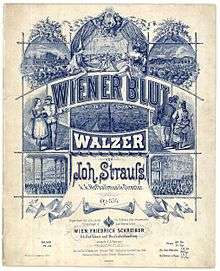Wiener Blut (waltz)

 |
|
| Problems playing this file? See media help. | |
Wiener Blut ('Viennese Blood' or 'Viennese Spirit') Op. 354 is a waltz by Johann Strauss II first performed by the composer on 22 April 1873. The new dedication waltz was to celebrate the wedding of the Emperor Franz Josef's daughter Archduchess Gisela Louise Maria and Prince Leopold of Bavaria. However, the waltz was also chiefly noted by Strauss' biographers as the début of Strauss with the world-renowned Vienna Philharmonic Orchestra where for many years, the Philharmonic had dismissed any association with the 'Waltz King' as it had not wished to be associated with mere 'light' or 'pops' music. The festival ball celebrating the event was held at the famed Musikverein Hall which is the venue for the famous present day Neujahrskonzert.
'Wiener Blut' is one of a handful of late works by Strauss that were not composed for the stage; at this point in his career he was concentrating on writing for the performing stage, and not for the ballroom, and had written at least 2 operettas before penning this waltz, with the famous Die Fledermaus still to come.
Description
The waltz begins with a high spirited melody in C major with references to later waltz sections briefly played. It is the gentle first waltz melody which is instantly recognisable, with lyrical grace and an enthusiasm not apparent in his earlier light-hearted creations. Waltz 2A is rather more subdued although waltz 2B uplifts the mood to the one listeners would be familiar with since the beginning of the piece. As a composition befitting the wedding of the royalty, the waltz has its moments of grandeur (Section 3) where a triumphant melody in the home key of C major gave way into a rousing Viennese tune in F major. The waltz has only 4 two-part sections as opposed to the earlier pattern of 5 two-part sections propounded by Josef Lanner and his father Johann Strauss I. The fourth section begins quietly in F major, with a climax with cymbals to come. The coda recalls earlier sections (2 and 3) in a different key of E major before the first waltz theme comes in again. The finale is exciting, with a stirring timpani drumroll and a strong brass flourish.
In popular culture
Animated cartoons
- The waltz is heard when Strauss is playing the piano in the Tom and Jerry episode, "Johann Mouse".
Film
- Vienna Blood is a 1942 German film based on the operetta; the waltz of the same name features prominently in the movie.
- It is a running motif in the 1941 film Suspicion by Alfred Hitchcock.
- The Wiener Blut is heard in the 1997 film, Titanic, in one of the First Class passenger scenes of the ship.
- A version of the waltz is heard when Sherlock Holmes, Dr. John Watson and Madam Simza find her brother at a peace summit held at Switzerland in the 2011 film, Sherlock Holmes: A Game of Shadows, directed by Guy Ritchie.
References
- Based on original text by Peter Kemp, The Johann Strauss Society of Great Britain. Used with permission.